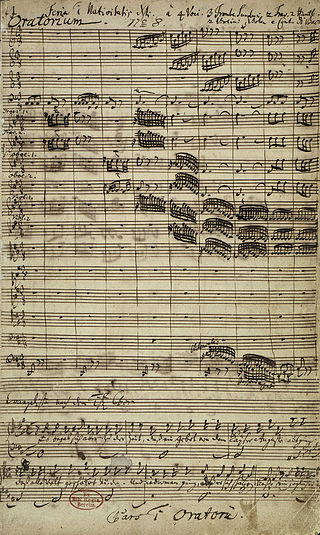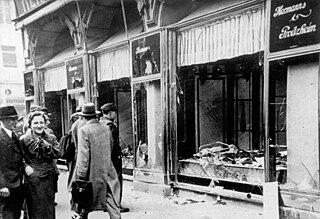
George FridericHandel was a German-British Baroque composer well known for his operas, oratorios, anthems, concerti grossi, and organ concertos. Handel received his training in Halle and worked as a composer in Hamburg and Italy before settling in London in 1712, where he spent the bulk of his career and became a naturalised British subject in 1727. He was strongly influenced both by the middle-German polyphonic choral tradition and by composers of the Italian Baroque. In turn, Handel's music forms one of the peaks of the "high baroque" style, bringing Italian opera to its highest development, creating the genres of English oratorio and organ concerto, and introducing a new style into English church music. He is consistently recognized as one of the greatest composers of his age.
An oratorio is a large musical composition for orchestra, choir, and soloists. Like most operas, an oratorio includes the use of a choir, soloists, an instrumental ensemble, various distinguishable characters, and arias. However, opera is musical theatre, while oratorio is strictly a concert piece – though oratorios are sometimes staged as operas, and operas are sometimes presented in concert form. In an oratorio, the choir often plays a central role, and there is generally little or no interaction between the characters, and no props or elaborate costumes. A particularly important difference is in the typical subject matter of the text. Opera tends to deal with history and mythology, including age-old devices of romance, deception, and murder, whereas the plot of an oratorio often deals with sacred topics, making it appropriate for performance in the church. Catholic composers looked to the lives of saints and histories from the Bible while Protestant composers only to Biblical topics. Oratorios became extremely popular in early 17th-century Italy partly because of the success of opera and the Catholic Church's prohibition of spectacles during Lent. Oratorios became the main choice of music during that period for opera audiences.

The Creation is an oratorio written in 1797 and 1798 by Joseph Haydn, and considered by many to be one of his masterpieces. The oratorio depicts and celebrates the creation of the world as described in the Book of Genesis.

Elijah, Op. 70, MWV A 25, is an oratorio by Felix Mendelssohn depicting events in the life of the Prophet Elijah as told in the books 1 Kings and 2 Kings of the Old Testament. It premiered on 26 August 1846.

The Birmingham Triennial Musical Festival, in Birmingham, England, founded in 1784, was the longest-running classical music festival of its kind. It last took place in 1912.

A compact fluorescent lamp (CFL), also called compact fluorescent light, energy-saving light and compact fluorescent tube is a fluorescent lamp designed to replace an incandescent light bulb; some types fit into light fixtures designed for incandescent bulbs. The lamps use a tube that is curved or folded to fit into the space of an incandescent bulb, and a compact electronic ballast in the base of the lamp.

Standing Stone is Paul McCartney's second full-length release of original classical music, although he defined it as orchestral music. It was issued shortly after the release of Flaming Pie. The world premiere performance was held at The Royal Albert Hall on 14 October 1997.

Raymond Charles Jack LaMontagne is an American singer-songwriter and musician. LaMontagne has released eight studio albums: Trouble, Till the Sun Turns Black, Gossip in the Grain, God Willin' & the Creek Don't Rise, Supernova, Ouroboros, Part of the Light, and Monovision. He was born in New Hampshire and was inspired to create music after hearing an album by Stephen Stills. Critics have compared LaMontagne's music to that of Otis Redding, Ryan Adams, Beck, Pink Floyd, The Band, Van Morrison, Nick Drake and Tim Buckley.

The Christmas Oratorio, BWV 248, is an oratorio by Johann Sebastian Bach intended for performance in church during the Christmas season. It is in six parts, each part a cantata intended for performance in a church service on a feast day of the Christmas period. It was written for the Christmas season of 1734 and incorporates music from earlier compositions, including three secular cantatas written during 1733 and 1734 and a largely lost church cantata, BWV 248a. The date is confirmed in Bach's autograph manuscript. The next complete public performance was not until 17 December 1857 by the Sing-Akademie zu Berlin under Eduard Grell. The Christmas Oratorio is a particularly sophisticated example of parody music. The author of the text is unknown, although a likely collaborator was Christian Friedrich Henrici (Picander).

Israel in Egypt, HWV 54, is a biblical oratorio by the composer George Frideric Handel. Most scholars believe the libretto was prepared by Charles Jennens, who also compiled the biblical texts for Handel's Messiah. It is composed entirely of selected passages from the Old Testament, mainly from Exodus and the Psalms.

A Child of Our Time is a secular oratorio by the British composer Michael Tippett (1905–1998), who also wrote the libretto. Composed between 1939 and 1941, it was first performed at the Adelphi Theatre, London, on 19 March 1944. The work was inspired by events that affected Tippett profoundly: the assassination in 1938 of a German diplomat by a young Jewish refugee, and the Nazi government's reaction in the form of a violent pogrom against its Jewish population: Kristallnacht. Tippett's oratorio deals with these incidents in the context of the experiences of oppressed people generally, and carries a strongly pacifist message of ultimate understanding and reconciliation. The text's recurrent themes of shadow and light reflect the Jungian psychoanalysis which Tippett underwent in the years immediately before writing the work.

Motivator is a British Thoroughbred racehorse and active sire. In a racing career which lasted from August 2004 until October 2005, he ran seven times and won four races. He is best known as the winner of the 2005 Epsom Derby. He was retired to stud, where he sired the dual Prix de l'Arc de Triomphe winner Treve.

The Triumph of Time and Truth is the final name of an oratorio by George Frideric Handel produced in three different versions across fifty years of the composer’s career:
The Maulbronn Chamber Choir was founded in 1983 and is directed by Jürgen Budday.
Sally Speare Lutyens was a composer, author, and librettist from Falmouth, Maine. She also resided in Portland and Manset, Maine, Weston, MA and Reading, PA.
Katia Plaschka is a German coloratura soprano who performs in opera, especially contemporary opera, and concert performances of oratorios.
New England is far from the center of the country, is relatively small, and is relatively densely populated. It was the birthplace of the Industrial Revolution in the United States as well as being one of the first regions to experience deindustrialization. Today, it is the center of education, research, high technology, finance, and medicine.
"Ermuntre dich, mein schwacher Geist" is a German Christmas carol with lyrics by Johann Rist and a melody by Johann Schop, first published in 1641. Historically it was contained in Protestant hymnals, but the current one, Evangelisches Gesangbuch, uses only three of its stanzas, the ninth, the second and the twelfth, titled "Brich an, du schönes Morgenlicht". This stanza was used by Johann Sebastian Bach as a chorale in Part II of his 1734 Christmas Oratorio.

Und es waren Hirten in derselben Gegend, BWV 248II, is a 1734 Christmas cantata by Johann Sebastian Bach as the second part of his Christmas Oratorio. Bach was then Thomaskantor, responsible for music at four churches in Leipzig, a position he had assumed in 1723.
Herr, wenn die stolzen Feinde schnauben, BWV 248VI, is a church cantata for Epiphany, which Johann Sebastian Bach composed as the sixth part of his Christmas Oratorio, written for the Christmas season of 1734–35 in Leipzig. The cantata was first performed on 6 January 1735.











